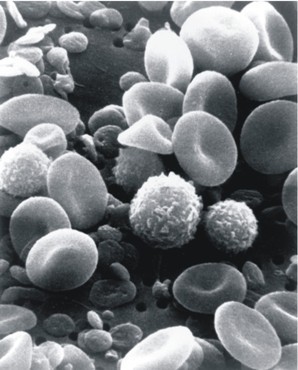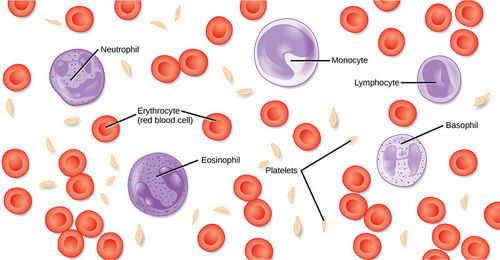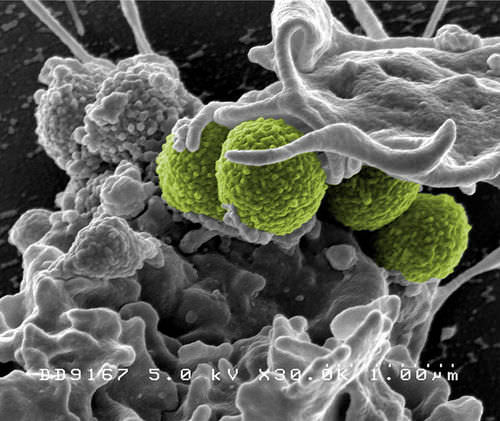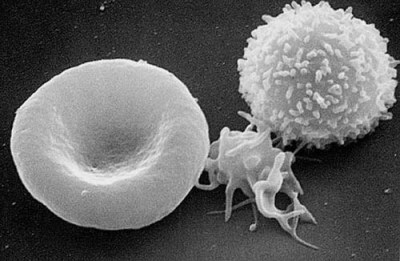3.6 血血的构成
章节大纲
-
What exactly is blood?
::什么是血?All your need oxygen, as oxygen is the final electron acceptor during . How do they get this oxygen? From blood. Blood cells flow through the vessels of the human . But what exactly is blood? It does transport oxygen, but it also has other functions.
::您需要氧气, 因为氧气是最后的电子接收器。 他们如何从血液中获取氧气? 血细胞通过人体的血管流动。 但是血液到底是什么? 它运输氧气, 但它也有其他功能 。The Composition of Blood
::血血的构成Blood is a fluid connective tissue . It circulates around the body through the due to the pumping action of the heart. Arterial blood carries oxygen and nutrients to all the body’s cells, and venous blood carries carbon dioxide and other metabolic wastes away from the cells.
::血液是一种流体连接组织,通过心脏的抽动作用在身体周围循环。 动脉血液携带氧气和营养物质进入身体的所有细胞,而静脉血液携带二氧化碳和其他代谢废物离开细胞。In addition to the transport of gases, nutrients, and wastes, blood has many other functions:
::除了气体、养分和废物的运输之外,血液还有许多其他功能:-
The removal of waste, such as carbon dioxide, urea, and lactic acid, from the body
tissues
.
::从人体组织中清除二氧化碳、尿素和杀菌酸等废物。 -
Defending the body against infections by microorganisms or
parasites
.
::保护身体免受微生物或寄生虫感染。 -
The repair of damaged body tissues.
::修复受损的人体组织。 -
The transport of chemical messages such as
and hormone-like substances.
::运输化学信息,如激素类物质。 -
The control of body pH (the normal pH of blood is in the range of 7.35 - 7.45).
::身体pH的控制(血液的正常pH值范围为7.35 - 7.45) -
The control of body temperature.
::控制体温
Blood is a colloid, a mixture of tiny particles dispersed evenly in a fluid and i t accounts for about 7% of the weight. The average adult has a blood volume of roughly 5 liters, which is composed of a fluid called plasma and several kinds of cells. Within the blood plasma are erythrocytes (red blood cells), leukocytes (white blood cells), thrombocytes (platelets), and other substances. The cells that make up the blood can be seen in Figure .
::平均成人的血液体积约为5升左右,由一种叫做等离子体的液体和几种细胞组成。血浆中包括红细胞、白血细胞、血栓细胞和其他物质。组成血液的细胞可以在图中看到。A scanning electron microscope (SEM) image of normal circulating human blood. One can see red blood cells, several white blood cells, including knobby lymphocytes, a monocyte, a neutrophil, and many small disc-shaped platelets.
::扫描电子显微镜(SEM)显示正常的人类血液循环。 人们可以看到红血球、几个白血细胞,包括Knobby淋巴细胞、单细胞、中微子和许多小盘状小板。Plasma
::Plasma 等离Plasma is the golden-yellow liquid part of the blood. Plasma is 90% and 10% dissolved materials including , glucose , ions , hormones, and gases. It acts as a buffer, maintaining pH near 7.4. Plasma is about 54% the volume of blood; cells and fragments make up about 46% of the volume.
::等离子体是血液中的金黄色液体部分,等离子体为90%和10%溶解材料,包括葡萄糖、离子、荷尔蒙和气体。它起到缓冲作用,将pH值维持在7.4附近。等离子体的血量约为54%;细胞和碎片占体积的46%。Red Blood Cells
::红血细胞Red blood cells , also known as erythrocytes, are flattened, doubly concave cells that carry oxygen. There are about 4 to 6 million cells per cubic millimeter of blood. Red blood cells make up about 45% of blood volume, as shown in Figure . Each red blood cell has 200 million hemoglobin molecules. Humans have a total of 25 trillion red blood cells (about 1/3 of all the cells in the body). Red blood cells are continuously made in the red marrow of long , ribs, the skull, and vertebrae . Each red blood cell lives for only 120 days, after which they are destroyed in the liver and spleen .
::红细胞,又称红血球细胞,是带有氧气的平坦的双重凝固细胞。每立方厘米的血液中大约有400万至600万个细胞。红细胞占血液量的45%,如图所示。每个红细胞有2亿个血红蛋白分子。人类共有25万亿个红细胞(大约占身体所有细胞的三分之一)。红细胞不断在长骨、肋骨、头骨和脊椎的红骨髓中组成。每个红细胞只活了120天,之后被肝脏和脾脏摧毁。The components of blood. Red blood cells make up about 45% of the blood volume. White blood cells make up about one percent and platelets less than one percent. Plasma makes up the rest of the blood.
::血的成分。红血细胞占血量的45%左右。白血细胞占1%左右,小板不到1%。血浆占其余的血液。Mature red blood cells do not have or other . They contain the protein hemoglobin, which gives blood its red color. The iron-containing heme portion of hemoglobin enables the protein to carry oxygen to cells. Heme binds to molecules of oxygen, which increases the ability of the blood to carry the gas.
::天然红血细胞没有血红蛋白或其它血红血红蛋白,含有蛋白血红蛋白,让血液染红。血红蛋白中含铁的血红蛋白部分使蛋白质能将氧气带入细胞。 Heme与氧分子结合,这增加了血液携带气体的能力。Iron from hemoglobin is recovered and reused by red marrow. The liver degrades the heme units and secretes them as pigment in the bile , which is responsible for the color of feces . Each second, two million red blood cells are produced to replace those taken out of circulation.
::来自血红蛋白的铁由红骨回收和再利用,肝脏降解了热量单位,并把它们分解为造成粪便颜色的易碎物中的色素,每秒产生200万个红细胞,以取代那些不流通的红细胞。White Blood Cells
::白血细胞White blood cells , also known as leukocytes, are generally larger than red blood cells, as shown in Figure . They have a nucleus but do not have hemoglobin. White blood cells make up less than one percent of the blood's volume. They are made from cells in bone marrow . They function in the cellular immune response system. There are five types of white blood cells. Neutrophils enter the tissue fluid by squeezing through capillary walls and phagocytize (swallow) foreign bodies. Macrophages also swallow and destroy cell debris and or . In Figure , a white blood cell is shown phagocytizing two bacteria. Macrophages also release substances that cause the numbers of white blood cells to increase. Antigen-antibody complexes are swallowed by macrophages. Lymphocytes fight infection. T-cells attack cells containing viruses. B-cells produce antibodies . To learn more about the role of white blood cells in fighting infection, refer to the Immune System concepts.
::白血细胞,也称为白血球,一般比红血细胞大,如图所示。它们有一个核,但没有血红蛋白。白血细胞占血液体积的不到1%。它们由骨髓细胞组成,在细胞免疫反应系统中发挥作用。有五类白血细胞。神经细胞通过阴道墙和外体(软体)挤压进入组织液中。大型细胞也吞咽和摧毁细胞残块,或者。在图中,白血细胞将两种细菌划为发形。宏观细胞还释放出导致白血细胞数量增加的物质。抗生素综合体被大型细胞吞噬。淋巴细胞抗感染。含有病毒的T细胞攻击细胞。B细胞产生抗体。更多了解白血细胞在抵抗感染中的作用,请参考Immune系统的概念。The relative sizes of red and white blood cells. Neutrophils, eosinophils, basophils, monocytes, and lymphocytes are white blood cells.
::红细胞和白细胞的相对体积。 白细胞是神经营养素、活性细胞、活性细胞、单细胞和淋巴细胞。A white blood cell showing cytoplasmic extensions that allow it to “swallow” particles or pathogens.
::白血球,显示细胞图象扩展,使其能“吞噬”粒子或病原体。Platelets
::发牌Platelets , also known as thrombocytes, are important in blood clotting. Platelets are cell fragments that bud off bone marrow cells called megakaryocytes. A platelet is shown in Figure . They make up less than one percent of blood volume. Platelets carry chemicals essential to blood clotting. They change fibrinogen into fibrin, a protein that creates a mesh onto which red blood cells collect, forming a clot. This clot stops more blood from leaving the body and also helps prevent bacteria from entering the body. Platelets survive for 10 days before being removed by the liver and spleen. There are 150,000 to 300,000 platelets in each milliliter of blood. Platelets stick to tears in blood vessels, and they release clotting factors.
::切片,又称血栓细胞,在血凝块中很重要。 切片是细胞碎片,从被称为巨型虫细胞的骨髓细胞中萌芽。 图中显示了一个小板块。 它们占血量的不到1%。 切片含有血液凝血所必需的化学物质。 它们将纤维素转化为纤维素, 一种蛋白质, 形成血块, 形成红血细胞聚集的网状。 这个块块阻止更多的血液离开身体, 也有助于防止细菌进入身体。 切片在被肝脏和脾脏取走之前存活了10天。 每升血液中都有15万至30万个小板。 血浆粘在血管中流泪, 并释放了凝块因素 。Cells of the blood. From left to right: red blood cell, platelet, white blood cell. The concave side of the red blood cell can be seen. Both sides of red blood cells are concave. The biconcave shape gives the red blood cells a smaller surface to volume ratio, which allows them to pick up large amounts of oxygen.
::血细胞。 从左到右: 红血细胞, 板块, 白血细胞。 红血细胞的混凝面可以看到。 红血细胞的两侧都是混凝土。 双层的血细胞形状使红血细胞的表面与体积的比例较小, 这使得红血细胞能够收集大量氧气 。Other Blood Components
::其他血液成分Blood plasma also contains substances other than water. Some important components of blood include the following:
::血浆还含有水以外的物质。-
Serum albumin: a plasma protein that acts as a transporter of hormones and other molecules.
::血清蛋白:一种血浆蛋白,作为荷尔蒙和其他分子的传送器。 -
Antibodies: proteins that are used by the immune system to identify and destroy foreign objects such as bacteria and viruses.
::抗体:免疫系统用来识别和销毁细菌和病毒等外来物体的蛋白质。 -
Hormones: chemical messengers that are produced by one cell and carried to another.
::荷尔蒙:化学信使,由一个细胞生产,然后送到另一个细胞。 -
Electrolytes such as sodium (Na
+
) and chloride (Cl
-
) ions.
::电解液,如钠(Na+)和氯化物(Cl-)离子。
Production and Breakdown of Blood Cells
::血细胞的生产和分类Blood cells are produced in the red and yellow bone marrow in a process called hematopoiesis. The currently accepted theory of hematopoiesis is called the monophyletic theory. It simply postulates that a single type of stem cell gives rise to all the mature blood cells in the body. This stem cell is an example of a pluripotent stem cell.
::血细胞在红和黄骨髓中产生,其过程称为血蛋白。目前接受的血蛋白理论称为单一植物理论。它只是假设单一类型的干细胞会产生身体中所有成熟的血细胞。这种干细胞是多功能干细胞的一个例子。Blood cells are broken down by the spleen and certain cells in the liver. The liver also clears some proteins, , and amino acids from the blood. The actively secretes waste products of the blood into the urine .
::血细胞被脾脏和肝脏中的某些细胞分解,肝脏还清除了血液中的某些蛋白质、氨基酸和氨基酸。积极将血液的废品分解到尿液中。Summary
::摘要-
Functions of blood include transport of nutrients, removal of waste, defense of the body, repair of damaged tissue, transport of chemical messages, control of pH, and control of temperature.
::血液的功能包括营养物的运输、废物的清除、身体的防护、受损害组织的修复、化学电文的运输、pH值的控制以及温度的控制。 -
Blood is composed of 54% plasma and 46% cells/fragments. Red blood cells make up about 45% of the volume.
::血浆由54%的血浆和46%的细胞/碎片组成,红血细胞占体积的45%左右。 -
White blood cells are made from stem cells in bone marrow and function in the cellular immune response system.
::白血细胞由骨髓干细胞和细胞免疫反应系统中的功能组成。 -
Platelets are cell fragments that bud off bone marrow cells called megakaryocytes; platelets carry chemicals essential to blood clotting.
::血小板是细胞碎片,由骨髓细胞(称为大卡约细胞细胞)发芽;小板上含有血液凝结所必需的化学物质。
Review
::回顾-
What type of solution is blood an example of?
::血是什么样的解决办法? -
How many liters of blood does an average adult have?
::平均成年人有多少升血? -
Where are red blood cells made?
::红细胞在哪里制造的? -
What distinguishes mature red blood cells?
::是什么区分成熟的红细胞? -
How do platelets begin the blood clotting process?
::血块是如何开始血凝结过程的?
-
The removal of waste, such as carbon dioxide, urea, and lactic acid, from the body
tissues
.





